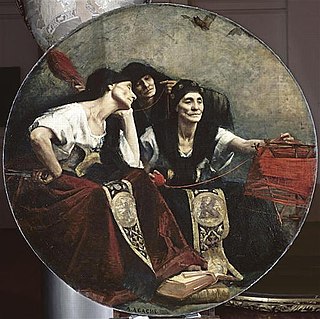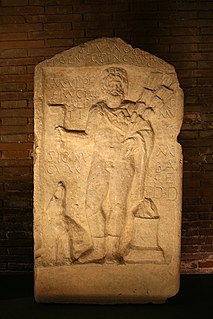
Atropos or Aisa, in Greek mythology, was one of the three Moirai, goddesses of fate and destiny. Her Roman equivalent was Morta.
Morta was wife of Mindaugas, the first known ruler of the Grand Duchy of Lithuania. She was the Grand Duchess of Lithuania and later Queen consort of Lithuania (1253–1262). Very little is known about her life. Probably, Morta was Mindaugas' second wife as Vaišvilkas, the eldest son of Mindaugas, was already a mature man active in international politics when Morta's sons were still young and dependent on the parents. After her death, Mindaugas married her sister, the wife of Daumantas. In revenge, Daumantas allied with Treniota and assassinated Mindaugas and two of Morta's sons in 1263.

In ancient Roman religion and myth, the Parcae were the female personifications of destiny who directed the lives of humans and gods. They are often called the Fates in English, and their Greek equivalent were the Moirai.

Silvanus was a Roman tutelary deity of woods and uncultivated lands. As protector of the forest, he especially presided over plantations and delighted in trees growing wild. He is also described as a god watching over the fields and husbandmen, protecting in particular the boundaries of fields. The similarly named Etruscan deity Selvans may be a borrowing of Silvanus, or not even related in origin.
Áine is an Irish goddess of summer, wealth and sovereignty. She is associated with midsummer and the sun, and is sometimes represented by a red mare. She is the daughter of Egobail, the sister of Aillen and/or Fennen, and is claimed as an ancestor by multiple Irish families. As the goddess of love and fertility, she has command over crops and animals and is also associated with agriculture.
In Irish mythology, Clíodhna is a Queen of the Banshees of the Tuatha Dé Danann. Clíodna of Carrigcleena is the potent banshee that rules as queen over the sidheog of South Munster, or Desmond.

In Mesopotamian mythology, Ereshkigal was the goddess of Kur, the land of the dead or underworld in Sumerian mythology. In later East Semitic myths, she was said to rule Irkalla alongside her husband Nergal. Sometimes her name is given as Irkalla, similar to the way the name Hades was used in Greek mythology for both the underworld and its ruler, and sometimes it is given as Ninkigal, lit. "Lady of the Great Earth".

Nona was one of the Parcae, the three personifications of destiny in Roman mythology, and the Roman goddess of pregnancy. The Roman equivalent of the Greek Clotho, she spun the thread of life from her distaff onto her spindle. Nona, whose name means "ninth", was called upon by pregnant women in their ninth month when the child was due to be born.

Beira is the name given by 20th-century folklorist Donald Alexander Mackenzie to the Cailleach Bheur, the personification of winter and the mother of all the gods and goddesses in Scottish mythology. She is associated with one of the Celtic creation myths and bears a similar role to Gaea in Greek mythology and Jord in Norse mythology.

In Roman mythology, Morta was the goddess of death. She is one of the Parcae, related to the Roman conception of the Fates in Greek mythology, the Moirai. Her Greek equivalent is Atropos. She is responsible for the pain and/or death that occur in a half-wake, half-sleep time frame. Her father is the god of darkness and her mother is the goddess of night. She visits and warns in advance of the pain and/or death about to be endured.
Bog-wood, also known as abonos and morta, especially amongst pipe smokers, is a material from trees that have been buried in peat bogs and preserved from decay by the acidic and anaerobic bog conditions, sometimes for hundreds or even thousands of years. The wood is usually stained brown by tannins dissolved in the acidic water. Bog-wood represents the early stages in the fossilisation of wood, with further stages ultimately forming jet, lignite and coal over a period of many millions of years. Bog-wood may come from any tree species naturally growing near or in bogs, including oak, pine (Pinus), yew (Taxus), swamp cypress (Taxodium) and kauri (Agathis). Bog-wood is often removed from fields and placed in clearance cairns. It is a rare form of timber that is claimed to be "comparable to some of the world's most expensive tropical hardwoods".
The House of Mindaugas was the first royal family of Grand Duchy of Lithuania, centered on Mindaugas, the first known and undoubted sovereign of Lithuania. He was crowned as King of Lithuania in 1253 and assassinated ten years later. His known family relations end with children; there is no data on his great-grandchildren or any relations with the Gediminids, a dynasty of sovereigns of Lithuania and Poland that started with Butigeidis ca. 1285 and ended with Sigismund II Augustus in 1572.
The Fates were a common motif in European polytheism, most frequently represented as a group of three mythological goddesses. They were often depicted as weavers of a tapestry on a loom, with the tapestry dictating the destinies of humans. The primary instances include:
In Roman mythology, Decima was one of the three Parcae, or often known in English as the Fates. Nona and Decima were responsible for birth, while Morta was charged with overseeing death. They distributed to mankind all the good and bad things in life, and even Jupiter had to bend to their will. She measured the thread of life with her rod, like her Greek equivalent Lachesis. Her mother is the goddess of night and her father is the god of darkness.

Somali mythology covers the beliefs, myths, legends and folk tales circulating in Somali society that were passed down to new generations in a timeline spanning several millennia. Many of the things that constitute Somali mythology today are traditions whose accuracy have faded away with time or have transformed considerably with the coming of Islam to the Horn of Africa.

Trees hold a particular role in Germanic paganism and Germanic mythology, both as individuals and in groups. The central role of trees in Germanic religion is noted in the earliest written reports about the Germanic peoples, with the Roman historian Tacitus stating that Germanic cult practices took place exclusively in groves rather than temples. Scholars consider that reverence for and rites performed at individual trees are derived from the mythological role of the world tree, Yggdrasil; onomastic and some historical evidence also connects individual deities to both groves and individual trees. After Christianization, trees continue to play a significant role in the folk beliefs of the Germanic peoples.

Piotr Paweł Morta is a Polish political activist, dissident, economist, co-inventor, activist in underground "Solidarity", Krajowy Mistrz Racjonalizacji 1983, and vice-chairman of European Works Council Pfleiderer AG.








